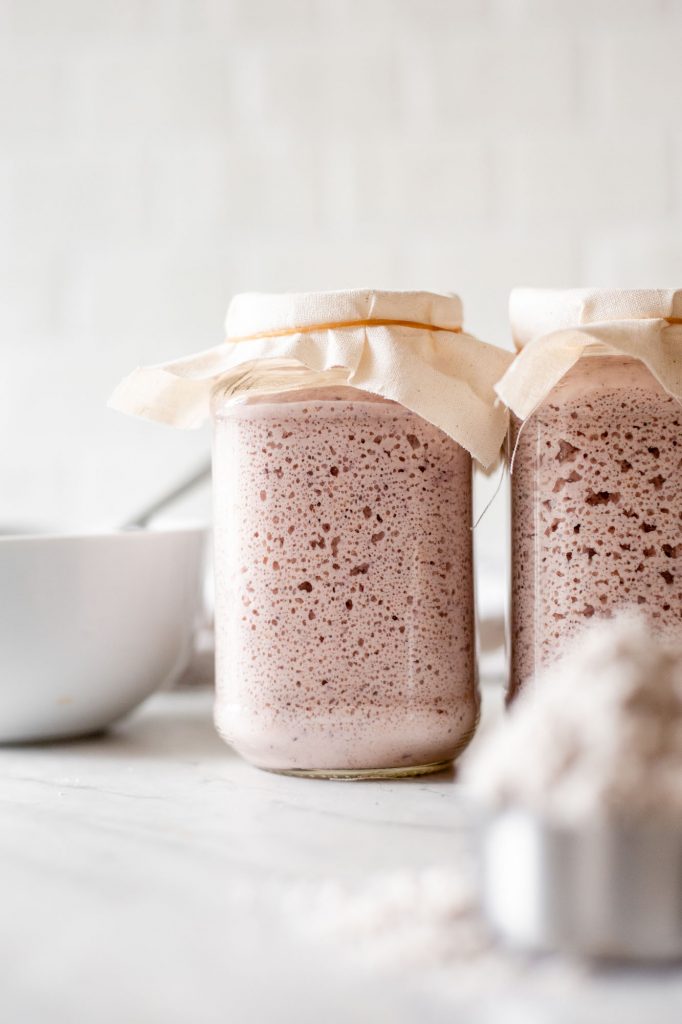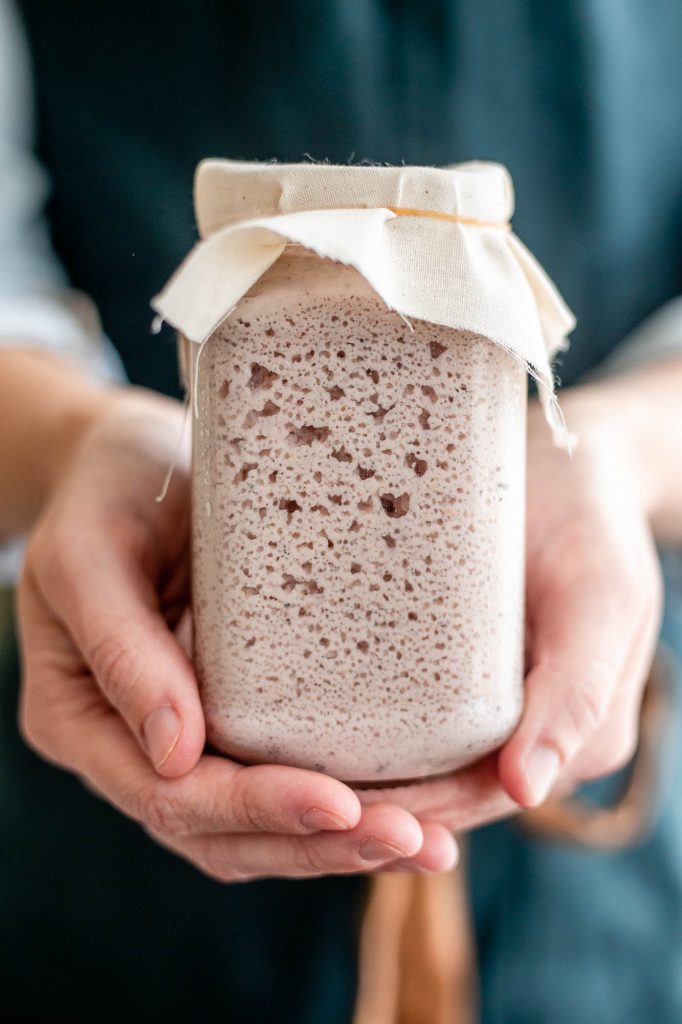Do sourdough starters work with gluten-free flour? Can gluten-free flour rise with yeast? I’ve got the answers for you in this blog post! It’s easy to make gluten-free sourdough bread with this homemade gluten-free sourdough starter recipe. You only need a few ingredients and one week to make your starter from scratch, and you will be baking gluten-free sourdough bread in no time. Adding amazing flavor and more nutrients to your gluten-free bread with this simple sourdough starter recipe.
Does Sourdough Starter Work With Gluten-Free Flour?
Yes! You can make a sourdough starter from scratch or adjust your regular starter to gluten-free flour feedings. If you adjust a starter that has been fed with gluten-containing flour, it works really well, but it won’t be safe for people with celiac disease.
The main differences you can expect with a gluten-free starter vs a regular starter:
- The starter will be thicker and chunkier after feeding & fermentation. Gluten-free flour is not as smooth.
- There are more funky smells when first getting a GF starter going. Just keep discarding and feeding in the beginning; the smells get better.
- There is always a semi-thick dry layer on top of the starter after feeding & fermentation.
All About Sourdough Starters.
When it comes to sourdough, everyone likes to focus on the wild yeasts, but a sourdough starter isn’t all yeast; it’s a mix of yeasts, lactic acid-producing bacteria, and acetic acid-producing bacteria. In wild sourdough starters, yeasts first ferment wheat carbohydrates into alcohol and carbon dioxide. Then, bacteria in the sourdough starter metabolize the alcohols produced by the yeasts into acetaldehyde and then into acetic acid… making it sour.
Have you ever experienced your starter smelling like acetone (nail polish)? That means that the bacteria in your starter need more oxygen to finish converting alcohol into acetic acid. If there isn’t enough oxygen, the bacteria get stuck in the middle of the conversion process, with a build-up of acetaldehyde. Once you expose them to more oxygen by stirring or feeding, they can finish converting acetaldehyde into acetic acid.
Have you ever experienced your sourdough starter rising and expanding twice after one feeding… probably after waiting longer than 24 hours to discard and feed? This is a good sign; it means there are lots of good bacteria present… But you should probably feed stat. Here’s what’s happening microbially: when yeasts start to metabolize the flour into alcohol, they also produce carbon dioxide, which is the first expansion of the starter. You may notice the sourdough starter fall and then rise again. The second rise is from bacteria metabolizing built-up alcohol into acetaldehyde. More carbon dioxide is produced as a byproduct when they do this, which adds more bubbles to the starter. Cool huh?
A Truly Mixed Fermentation
Fermentation in sourdough starters doesn’t happen in succession. As soon as the yeasts produce any alcohol, the bacteria metabolize whatever alcohol is present into acids. So things do get sour early on. It’s not like the yeasts make all the alcohol first, and then days later, the bacteria decide to start metabolizing it. It’s simultaneous since it is a rich, wild, mixed culture.
Yeasts make bubbles and visible expansion in a starter, but bacteria make all the flavor. Bacteria start making things sour on day one. The bacteria can also metabolize carbohydrates from the flour into acids outright, and then there are wild yeasts that metabolize the lactic acid produced by bacteria for energy. When more good bacteria are present, they can help boot yeast populations by feeding them usable acids and eliminating the waste products (alcohol). The point of discarding and feeding is to refresh the usable substrates available to all the microbes so that the accumulation of waste products does not kill the yeast and bacteria. Sourdough is fascinating because there are so many different types of microbial metabolism and fermentation happening all at once.
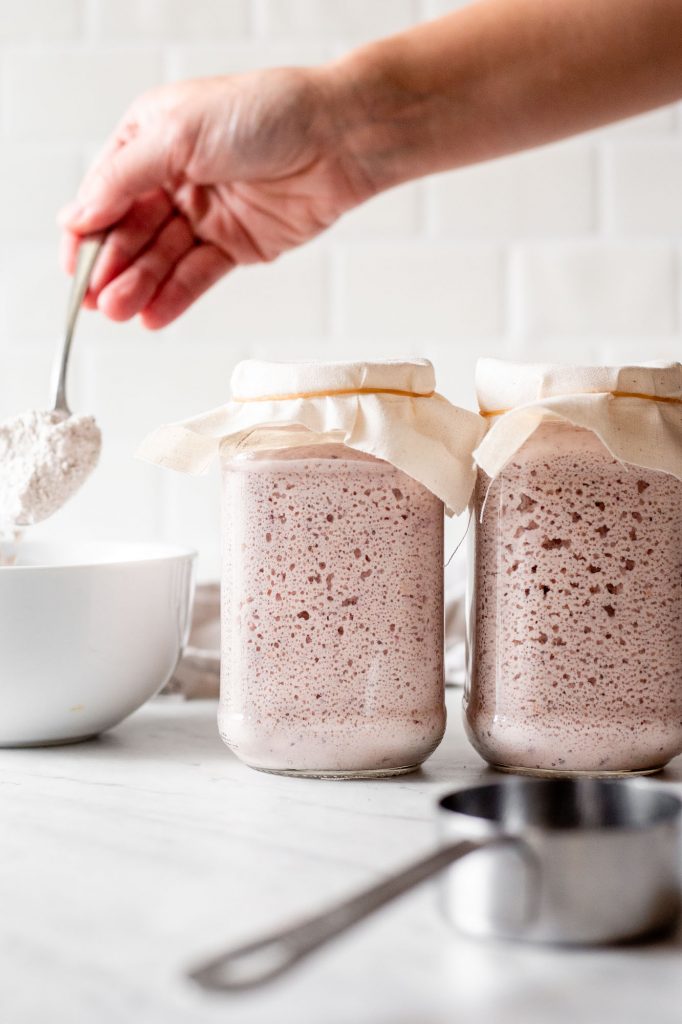
Ingredients and Tools
- Flour: I use a mix of gluten-free flours that I developed based on my best flavor results in GF bread tests.*See GF sourdough starter flour mix discussed in the section below*
- Water: Filtered water is best, but you can use tap water if you have good tap water. I use tap water that has been filtered through our water filter pitcher.
- Glass Jars and Cheesecloth: I like to use a quart-sized, wide-mouth mason jar with some cheesecloth on top to grow my sourdough starter. The mixture needs access to air to grow, so you cannot use a traditional mason jar lid. I just secured the cheesecloth to the jar with a rubber band. I like to use two jars and switch back and forth between feedings, so I always have a freshly clean jar.
- Kitchen Scale: If you frequent our blog, you should already have one of these on hand. You can find a good kitchen scale option HERE. If you’re going to master fermentation and baking, you definitely need a kitchen scale. If you’re going to experiment with different flours for your GF sourdough starter, you should use your kitchen scale for measurements. Some flours are denser than others, so you need to weigh for recipe consistency. Nobody enjoys a dense loaf of bread.
- Environment: Temperature is important when it comes to growing healthy yeast and bacteria in a sourdough starter. Your kitchen temperature should be between 68-78 degrees F. It can be warmer or cooler, but the rise time will be affected.
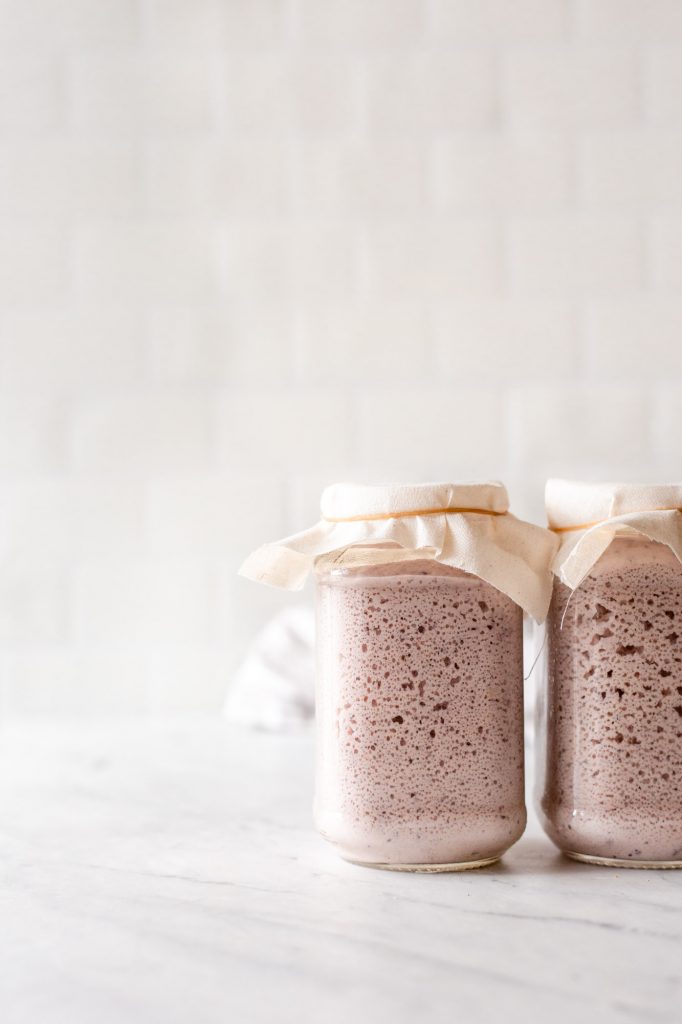
The Best Gluten-Free Flour for Sourdough Starters
I make my own mix of gluten-free flour for feeding my GF sourdough starter. It’s a simple mix of:
- 300 grams blue corn masa flour
- 300 grams Bob’s Red Mill 1:1 Gluten-Free Flour
- 150 grams sorghum flour
I usually make this mix, then store it in an air-tight glass container specifically for sourdough starter feedings. This sourdough starter recipe does work well with feeding 100% Bob’s Red Mill 1:1 Gluten-Free Flour.
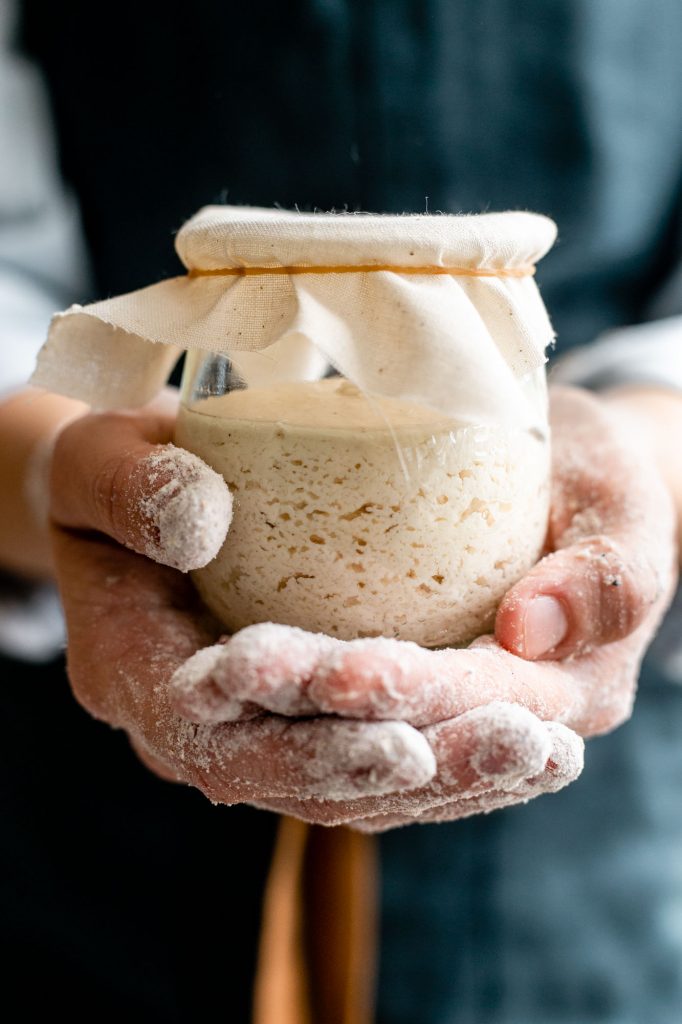
Can Gluten-Free Flour Rise with Yeast?
Yes, gluten-free flour can rise with packaged yeast or with wild yeast in a sourdough starter. And with the right bread recipe, the rise is beautiful!
Here’s the thing about gluten-free flour rising with yeast, though: you MUST shape the bread before allowing it to rise. This is NOTHING like glutinous bread dough. There is no punch-down, no stretching or folding, no pre-shaping then shaping. There is one rise and one rise only.
This is why I chose the loaf-pan method for our gluten-free sourdough bread recipe. It allows for a higher water content and no need to try and shape something that includes no gluten to hold everything together.
How to Discard and Feed Gluten-Free Sourdough Starter
You discard and feed a gluten-free sourdough starter just like a regular sourdough starter. See the section above on the best gluten-free flour for sourdough starters.
Step One (Day 1)
- In your glass jar combine:
- 50 grams of gluten-free flour blend
- 100 grams of water
- Use a spatula to combine the flour and water. Stir until there are no clumps and the mixture is smooth. Make sure to scrape down any mixture from the sides of the jar.
- Secure a breathable covering to the jar (i.e. cheesecloth, or any tight-weave cloth) and leave the mixture on the counter for 24 hours.
Step Two (Day 2)
- Stir sourdough starter mixture, you may notice that the texture is thicker and “chunky”. This is normal.
- Add in 30 grams of gluten-free flour and 60 grams of water.
- Mix and scrape down the sides. Replace a breathable lid. Leave the mixture on the counter for 24 hours.
Step Three (Days 3-7, Feeding and Discarding)
- In a clean jar add:
- 50 grams sourdough starter mixture
- 50 grams gluten-free flour
- and 100 grams water
- Stir until evenly combined, and scrape down the sides of the jar. Replace the breathable lid and allow it to ferment for 24 hours. *if you want to actually see the bubbles and rise in the starter, check it at 8 to 12 hours.*
- Discard any remaining original starter mixture. Or you can find fun ways to use sourdough starter discard.
- Repeat every 24 hours through day 7.
Step 4 (The Night Before Baking)
- (you will want to use a bigger jar here) 12 hours before baking add to your starter:
- 50 grams gluten-free flour
- 100 grams water
- Stir until evenly combined, and scrape down the sides of the jar. It should be about the consistency of cake batter. Replace the breathable lid and allow it to ferment for 12 hours.
Day 8 (Baking Day)
- If your starter shows signs of bubbling and rising you can use it for baking.
How to Make Gluten-Free Sourdough Bread
- try our easy recipe (link)
I developed our gluten free sourdough bread recipe with four priorities in mind. I wanted this bread to be:
- Soft, but sturdy and easy to cut
- Full of sourdough flavor
- Extremely easy to make with minimal ingredients
- No eggs.
I can say that I nailed it. Our gluten-free sourdough bread recipe checks off all my standards. It is absolutely delicious, soft yet able to hold together, egg-free, and ridiculously easy to make. Seriously, this gluten-free sourdough comes together in just 5 minutes. Then, all you have to do is let it ferment and rise before baking.
Sourdough Starter Problems
With gluten-free sourdough starters, the troubleshooting is about the same as regular sourdough starters. If you encounter any issues with your gluten-free sourdough starter, check out this article: The Most Common Sourdough Starter Problems and How to Fix Them.
PrintLearn How to Make a Gluten-Free Sourdough Starter From Scratch
Do sourdough starters work with gluten-free flour? Can gluten-free flour rise with yeast? I’ve got the answers for you in this blog post! It’s easy to make gluten-free sourdough bread with this homemade gluten-free sourdough starter recipe. You only need a few ingredients and one week to make your starter from scratch, and you will be baking gluten-free sourdough bread in no time. Adding amazing flavor and more nutrients to your gluten-free bread with this simple sourdough starter recipe.
- Prep Time: 10
- Total Time: 10 minutes
- Category: Sourdough
- Method: Fermentation
- Diet: Vegan
Ingredients
- Gluten-Free flour mix*
- water
Instructions
- In your glass jar, combine 50 grams GF flour mixture and 100 grams of water.
- Use a spatula to combine the flour and water. Stir until there are no clumps and the mixture is smooth. Make sure to scrape down any mixture from the sides of the jar.
- Secure a breathable covering to the jar (i.e., cheesecloth) and leave the mixture on the counter for 24 hours.
- (Day 2) Stir the GF sourdough starter. Add in 30 grams of your flour mixture and 60 grams of water. Mix and scrape down the sides. Replace a breathable lid. Leave the mixture on the counter for 24 hours.
- (Days 3-7, Feeding and Discarding). Add 50 grams starter mixture, 50 grams of GF flour mixture, 100 grams of water in a clean jar. Note: these amounts result in a lot of starter discard; feel free to cut the amounts in this step by half to conserve flour.
- Stir until evenly combined, and scrape down the sides of the jar. Replace the breathable lid and allow it to ferment for 24 hours.
- Discard the remaining starter mixture. Or you can find fun ways to use sourdough starter discard.
- Repeat every 24 hours through day 7.
- (The Night Before Baking). 12 hours before baking, do not discard and add 50 grams of your GF flour mixture and 100 grams of water to your starter. You may need to size up to a bigger jar when feeding the night before baking.
- Stir until evenly combined, and scrape down the sides of the jar. Replace the breathable lid and allow it to ferment for 12 hours.
- (Baking Day). Gluten-free starters may not pass a “float test.” If you see bubbles in the starter, it smells pleasantly sour, and it has clearly risen; you can use it for baking.
- Put 50 grams GF starter mixture aside and continue feeding as in days 3-7 for your next baking day. Use the rest for your bread recipe. Click Here for my gluten-free sourdough bread recipe.
Notes
- *I use a mix of 1:1 gluten-free flour, blue corn masa flour, and sorghum flour. Please see the body of this blog post for details on the flour blend ratio I use to feed my GF sourdough starter.
Keywords: sourdough, gluten free, bread, starter
The post Learn How to Make a Gluten-Free Sourdough Starter From Scratch appeared first on Cultured Guru.
-------------------------
By: Kaitlynn Fenley
Title: Learn How to Make a Gluten-Free Sourdough Starter From Scratch
Sourced From: cultured.guru/blog/learn-how-to-make-a-gluten-free-sourdough-starter-from-scratch?utm_source=rss&utm_medium=rss&utm_campaign=learn-how-to-make-a-gluten-free-sourdough-starter-from-scratch
Published Date: Wed, 29 Sep 2021 22:12:39 +0000
Did you miss our previous article...
https://biohackersnews.com/gut-health/top-tips-on-cooking-for-a-healthy-gut
.png)
